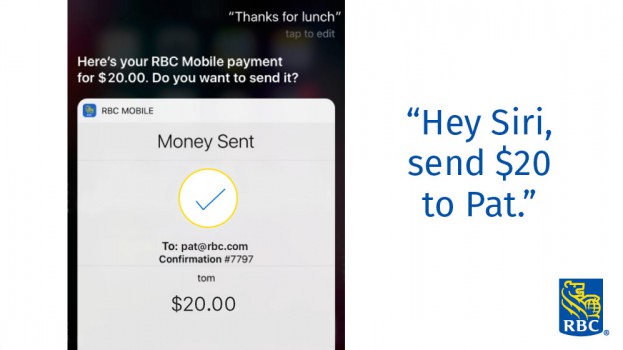You might already be using Siri as the quickest way to Google something or check the weather, but now RBC will allow customers to send cash through the voice-controlled personal assistant.
In the latest update to the bank’s iOS mobile app, a voice command as simple as “Hey Siri, send $20 to Pat” is all that is needed to initiate an Interac e-transfer. The app will then confirm the name with the customer’s existing payee list, and ask for a fingerprint scan to confirm the transaction.
While this kind of functionality is part of a greater shift towards more voice-controlled tech like Amazon’s Alexa, Nick Barbuto, managing director of OMD’s Ignition division, says this particular kind of use might be for the RBC brand, as opposed to serving a persistent consumer need.
“I think it’s evolutionary, but not revolutionary,” he says. “I don’t see it fitting into a lot of day-to-day use cases. It fits into fringe scenarios, like you’re in the car and you forgot to send someone a payment.
“I question the utilitarian value of being able to pay someone like this over doing it manually, but I do think it resonates at a brand level,” Barbuto says. “Being able to say ‘look at what my bank can do’ is where this plays best.”
That kind of approach to tech deployment from a bank isn’t totally unheard of. Tangerine uses fingerprint scanners, voice recognition and retinal scans to unlock its apps. While biometrics may not be any more secure than a strong password, it’s part of a user experience that reinforces how Tangerine is doing the innovative things you’d expect from a modern bank (and that it’s a brand you can trust) every time its app is used.
While RBC is the first bank to offer voice-command money transfers in Canada, PayPal launched its own Siri-powered transfers in the fall. In the U.S., Capital One has also launched a wide range of voice command functions through Alexa, like checking account balances or doing “quick actions” like paying the balance of a credit card.
For Barbuto, that kind of functionality is a better indication of the ways banks can utilize voice commands in a way that is closer to why voice controlled devices are more popular in home settings.
“A lot of internet connected devices all ladder up to the idea that you can be at home and not having to stop what you’re doing to start a playlist or a movie or call an Uber,” he says. “The Capital One app is interesting because it is a little bit closer to a more common daily scenario than sending payments. To some extent, sending payments through Siri feels like table stakes. Voice input does seem germane to an app, so why wouldn’t you add it, but there are better use scenarios that haven’t been made as of yet.”
























